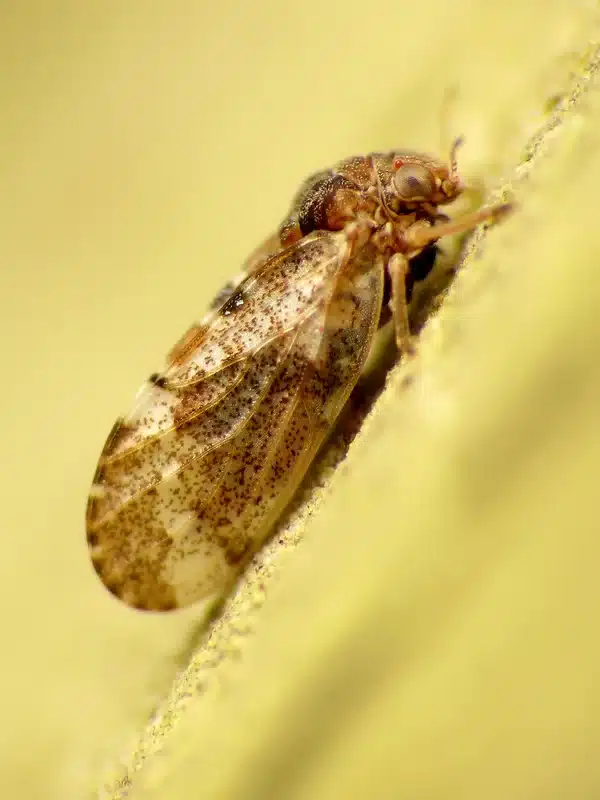If you’ve noticed tiny brown bugs clustering on your home’s light-colored siding this fall, you’re likely dealing with hackberry psyllids. These miniature jumping insects invade DMV area homes every autumn, creating quite a nuisance for homeowners.
Having worked as a registered technician for four years with our family business, I’ve seen countless hackberry psyllid invasions across the DC-Maryland-Virginia region. Our company has been serving the DMV for over 50 years, and these seasonal invaders remain one of the most common fall pest complaints we receive.
What Are Hackberry Psyllids?
Tiny Jumping Insects That Look Like Miniature Cicadas
Hackberry psyllids are small insects measuring just 2.5-3 mm long—roughly the size of an eighth of an inch. Adults have mottled brown bodies with clear-banded wings that they hold roof-like over their backs. Their enlarged hind legs give them a distinctive flea-like jump when disturbed.
Under magnification, these insects look remarkably like miniature cicadas, complete with large compound eyes and wings that extend beyond their abdominal tip. This jumping behavior helps distinguish them from other tiny brown bugs that might invade your home.
Complete Life Cycle on Hackberry Trees
Hackberry psyllids complete their entire life cycle on native hackberry trees (Celtis occidentalis and Celtis laevigata). The cycle begins when eggs are laid during bud-break in late March through April. Each egg develops through five nymphal stages, with each nymph living inside a protective gall on hackberry leaves.
These galls come in several shapes—nipple, button, blister, flask, and star formations. The nymphs inject salivary hormones that redirect normal leaf growth, creating these distinctive bumps and formations. Adults emerge from galls during late August through October, timing their emergence with the search for overwintering sites.
Why Hackberry Psyllids Invade Homes in Fall
Seeking Warm Overwintering Sites
When temperatures start dropping after the first cool nights of late summer, hackberry psyllids begin their search for protected overwintering locations. They aggregate on warm, sun-facing walls—especially south and west-exposed surfaces—while scouting for cracks and crevices to shelter in during winter.
These insects become active again during mid-winter thaws and early spring, which explains why homeowners sometimes discover “mystery gnats” in bedrooms long after windows have been closed for the season.
Entry Through Tiny Gaps and Standard Screens
Hackberry psyllids can squeeze through gaps as small as 0.2 mm around movable windows, storm door sweeps, soffit vents, and cable penetrations. Additionally, they routinely slip through intact window screens because standard 18-mesh screens have apertures of about 1.2 mm—much larger than these insects’ body width.
Common entry points include:
- Gaps around window and door casings
- Worn weather stripping
- Tears in window screens
- Soffit and ridge vents
- Utility line penetrations
Attraction to Light-Colored Surfaces
One of the most distinctive behaviors of hackberry psyllids is their strong attraction to light-colored surfaces. They orient toward high-contrast backgrounds and can cover white vinyl siding, painted trim, and window frames with hundreds of clustering insects on warm afternoons.
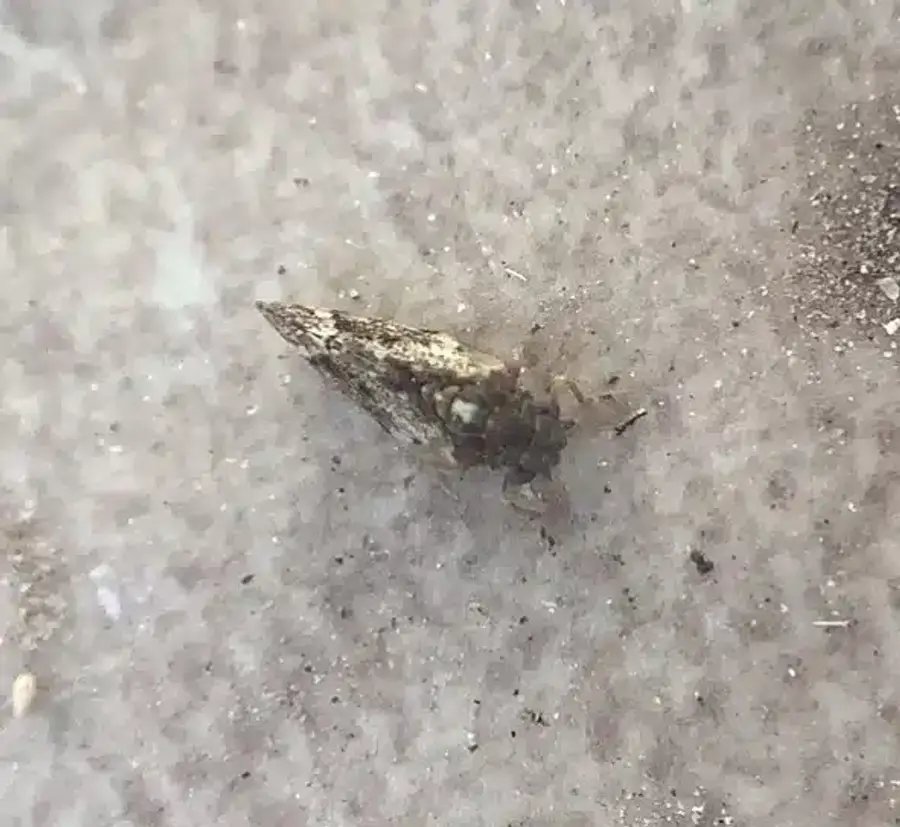
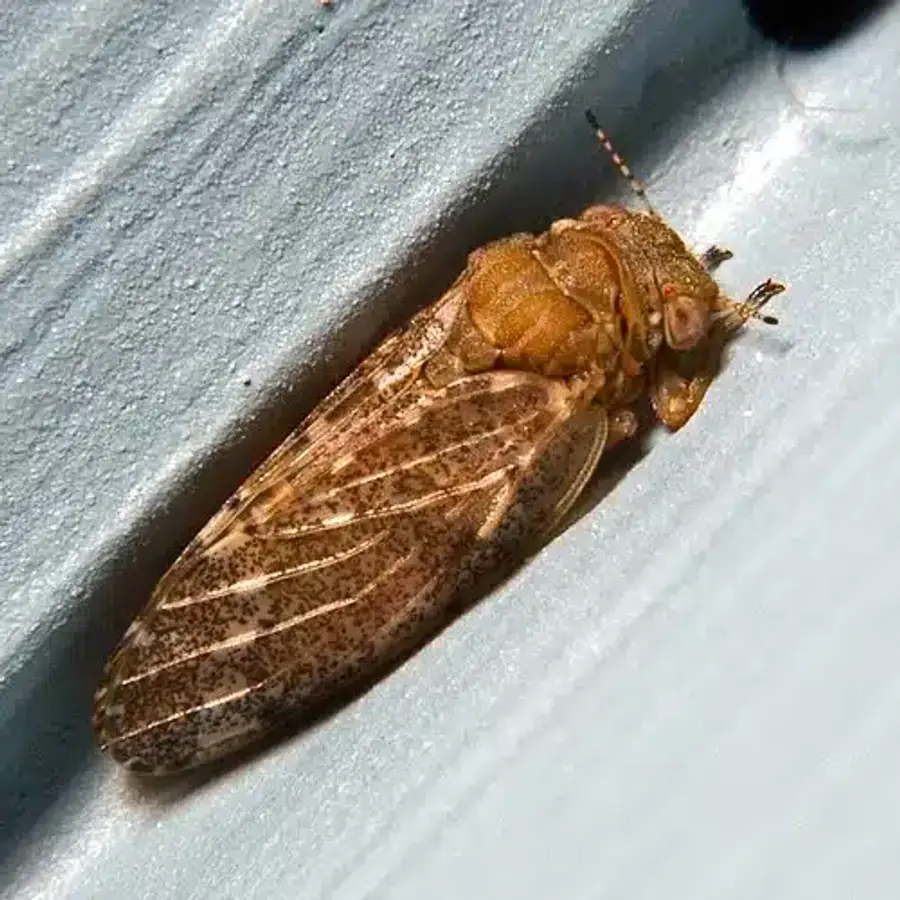

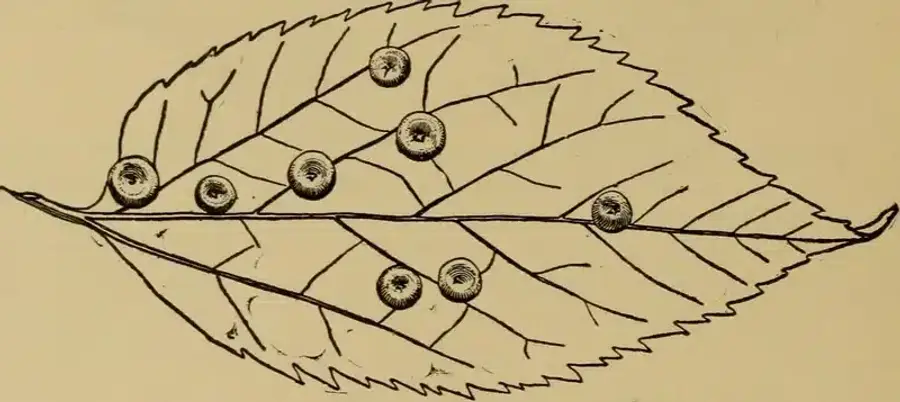
This phototactic behavior makes light-colored homes particularly susceptible to heavy invasions during peak emergence periods.
Are Hackberry Psyllids Harmful?
No Health Risks to People or Pets
Good News for Your Health
Hackberry psyllids pose no medical threats to humans or pets. They don’t reproduce indoors, don’t feed on stored products, and don’t transmit diseases. While some homeowners report “bites,” these are actually harmless exploratory skin probes that feel like a pin-prick but deliver no saliva or venom.
The insects are simply a nuisance pest, especially when numbers reach the millions that can emerge from a single heavily infested tree. Their jumpy movement and tendency to gravitate toward lamp shades and computer screens create the primary annoyance.
Minimal Impact on Tree Health
Even heavy galling from hackberry psyllids rarely compromises the health of established hackberry trees.
What does the science say?
According to University of Kentucky entomologists, the galls are primarily cosmetic, and trees typically recover fully by the following spring. Some premature leaf drop can occur with severe infestations, but canopy recovery is rapid and complete. The galls don’t significantly impact photosynthesis or overall tree growth in mature specimens.
How to Identify Hackberry Psyllid Infestations
Distinctive Galls on Hackberry Leaves
The first sign of hackberry psyllids often appears as small bumps or nipple-like protrusions on hackberry leaves. These galls form on both the upper and lower leaf surfaces and house the developing nymphs throughout the summer months.
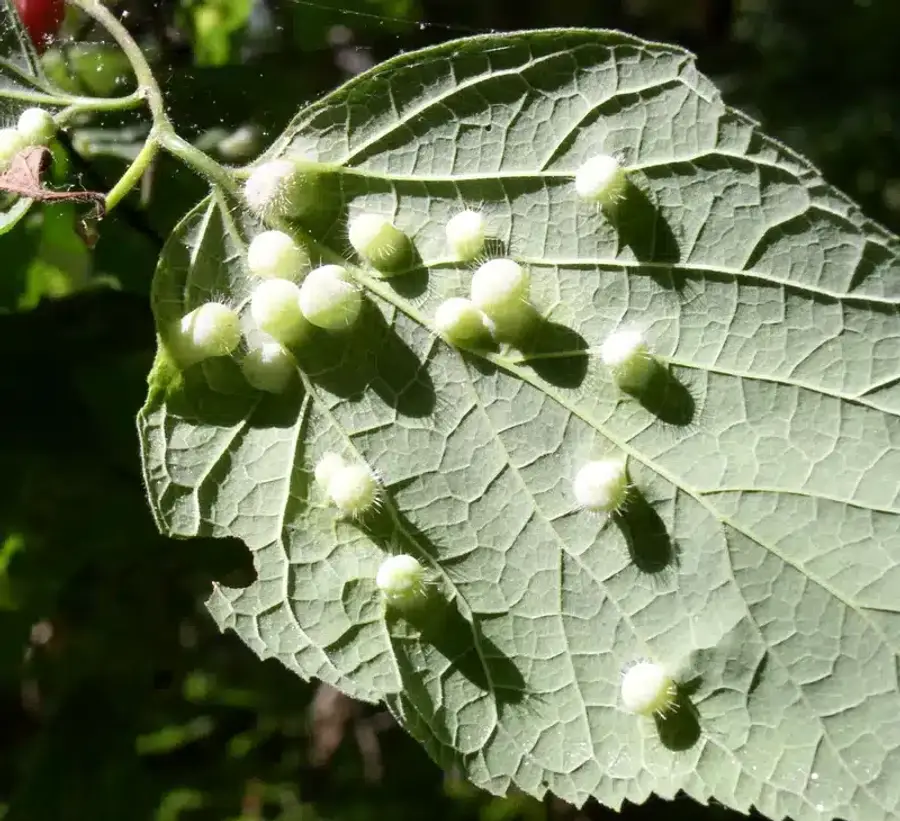

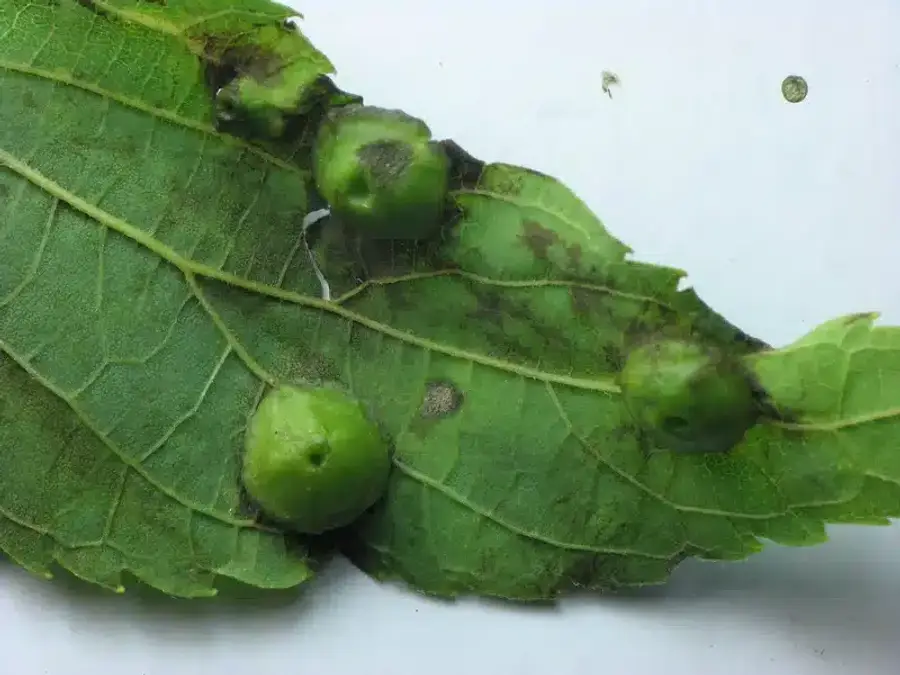
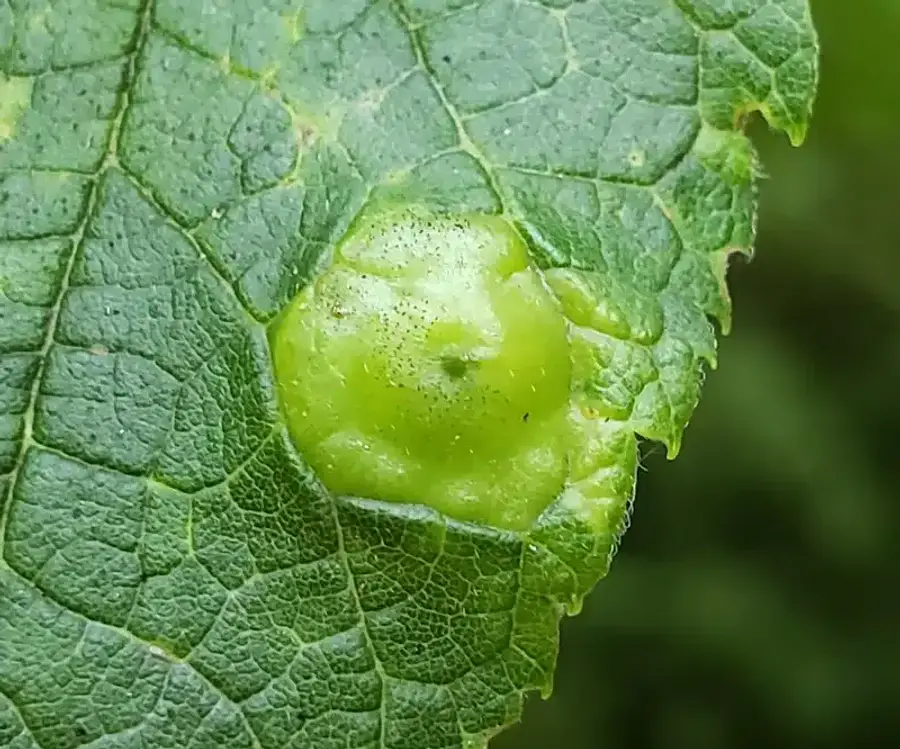
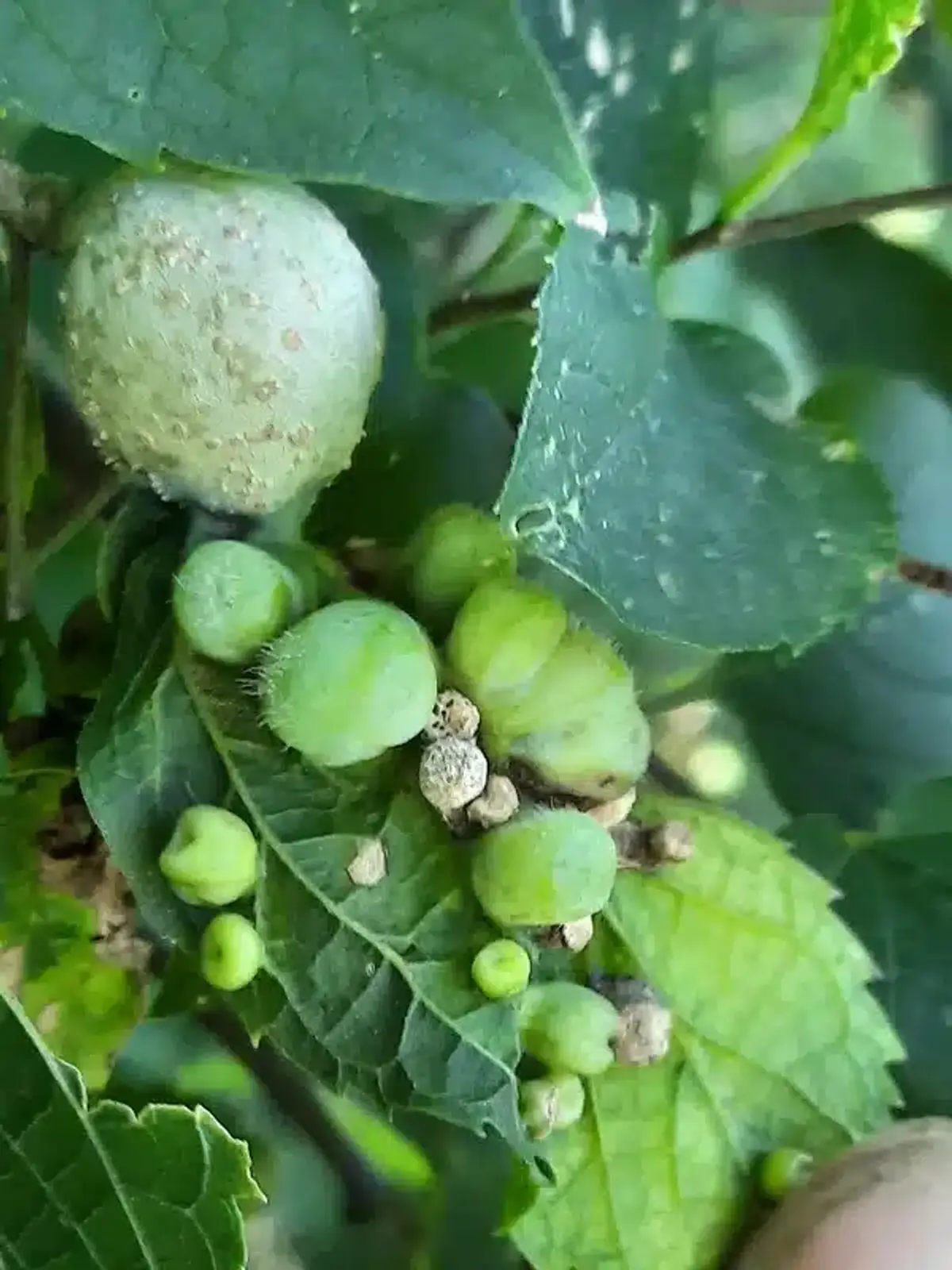
Gall types include:
- Nipple galls (most common)
- Button galls
- Blister galls
- Flask-shaped galls
- Star galls
Clustering Behavior on Buildings
Hackberry psyllids create obvious clusters on the sunny sides of buildings during their fall emergence. Unlike earwigs that hide in cracks or ants that follow trails through walls, these insects mass together on exposed surfaces.
Look for concentrations on south and west-facing walls, around window frames, and on light-colored siding materials. The insects remain relatively stationary during cool mornings but become active and jumpy when temperatures warm up.
DIY Control Methods for Hackberry Psyllids
Vacuum Removal Works Best Indoors
The most effective way to handle hackberry psyllids that make it inside is vacuuming with an extension wand. This method provides immediate results without introducing chemicals into your living space.
Power Washing and Hosing for Exterior Clusters
For heavy concentrations on siding and exterior walls, power washing or hosing off clusters provides effective temporary relief. Hackberry psyllid populations decline sharply after the first hard frost, making this a viable short-term strategy.
Time exterior cleaning for late afternoon when insects are most active and exposed. Early morning cleaning while insects are sluggish may miss individuals that are hidden in protected areas.
Home Exclusion and Sealing Techniques
Preventing hackberry psyllid entry requires thorough sealing of potential access points. Focus exclusion efforts on late summer before peak emergence begins.
Key Exclusion Steps
- Applying elastomeric caulk around window and door casings
- Installing 30-40 mesh insect screening
- Adding vinyl door sweeps to exterior doors
- Using foam backer-rod for larger gaps
- Weather-stripping garage doors
These same techniques that work for keeping ants away prove equally effective against hackberry psyllids seeking entry points.
Light Management to Reduce Attraction
Modifying outdoor lighting can significantly reduce hackberry psyllid attraction to your home. Switch porch and security fixtures to warm-LED or sodium “bug” bulbs that produce less attractive wavelengths.
Additionally, keep drapes and curtains closed on south and west-facing windows during peak flight periods to reduce indoor light cues that draw insects toward potential entry points.
Chemical Control Considerations for Hackberry Psyllids
Chemical treatments for hackberry psyllids face significant limitations. Foliar or systemic insecticides must contact leaves during the brief egg-hatch window in early April, requiring multiple applications on tall trees that are both logistically challenging and financially impractical.
What does the science say?
The University of Minnesota Extension notes that chemical approaches rarely provide cost-effective long-term control for this pest. Natural parasitic wasps (Torymus pachypsyllae and Psyllaephagus pachypsyllae) can kill up to 50% of nymphs in some years, explaining the strong year-to-year variation in outbreak intensity without any intervention.
Furthermore, adults can reinvade from neighborhood hackberry trees even after successful local treatments.
Permanent Solutions Through Tree Management
For chronic, high-volume invasions, removing or aggressively pruning female hackberry trees within approximately 150 feet of your home provides the only permanent solution. This approach eliminates the source rather than treating symptoms.
Better Termite & Pest Control’s Approach to Hackberry Psyllids
Our family business has developed a comprehensive strategy for managing hackberry psyllid invasions based on five decades of DMV area experience. We begin with expert phone consultation—you’ll speak directly with a licensed technician, not navigate phone trees or overseas operators.
Thorough Property Assessment
Our registered technicians perform a detailed 78-point home inspection, focusing specifically on overwintering pest entry points. We identify both active problem areas and potential trouble spots that could allow hackberry psyllid entry during future seasons.
This inspection covers window and door seals, screen conditions, soffit areas, utility penetrations, and other vulnerable points that these tiny insects exploit.
Exclusion-First Treatment Philosophy
We prioritize exclusion techniques over chemical treatments for hackberry psyllids. Our approach uses products that have passed through our internal research team—including Essentria, Alpine, and Borate-based solutions—representing alternatives to 9 harsh chemicals we’ve removed from our standard protocols.
For severe infestations, we may dust exterior voids including weep holes and areas behind siding to create barriers that deter entry without extensive spraying.
Seasonal Protection and Follow-Up
Our seasonal protection plan targets specific pests during their most active periods, creating year-round barriers around your home. For hackberry psyllids, this means October preparations before peak emergence and follow-up during winter months when stragglers become active during warm spells.
If you spot problems between scheduled visits, we’ll return at no additional cost until achieving acceptable control levels.
Seasonal Checklist for Managing Hackberry Psyllids
Late Summer Preparation (August)
Inspect window screens for tears and gaps. Replace damaged screens with 30-40 mesh material that blocks hackberry psyllid entry. Check weather stripping around doors and windows, replacing worn seals.
Caulk gaps around window and door casings using elastomeric caulk designed for exterior use. Pay special attention to south and west-facing openings where insects concentrate.
Early Fall Actions (September-October)
Switch outdoor lighting to warm-LED or sodium bulbs that attract fewer insects. Prepare vacuum cleaners with extension wands for quick indoor removal.
Close drapes and curtains on sunny sides of your home during warm afternoons when hackberry psyllid activity peaks. Monitor hackberry trees for emerging adult populations.
Post-Frost Clean-Up (November)
Power-wash or hose clusters from siding and exterior walls after the first hard frost eliminates active populations. Vacuum any remaining insects that made it indoors during the invasion period.
Use this quieter period to complete any remaining exclusion work and prepare for potential mid-winter activity during warm spells.
Winter Monitoring (December-February)
Watch for “mystery gnats” in bedrooms and living areas during mid-winter thaws when overwintering hackberry psyllids temporarily reactivate. These stragglers indicate successful overwintering sites that need sealing.
Plan spring exclusion improvements based on winter discoveries of entry points you may have missed during fall preparations.
Professional Help When DIY Isn’t Enough
While many homeowners successfully manage hackberry psyllid invasions using exclusion and vacuuming, some situations require professional intervention. Properties with multiple large hackberry trees or homes with numerous entry points may need comprehensive treatment plans.
Our team brings three generations of pest control experience to challenging situations. We can assess whether tree management, advanced exclusion techniques, or targeted treatments offer the best long-term solutions for your specific property.
Remember that hackberry psyllid invasions are seasonal and temporary—“this too shall pass.” Most situations resolve with patience, proper exclusion, and basic removal techniques. However, chronic high-volume invasions may warrant professional consultation to explore all available options.
Frequently Asked Questions
How big are hackberry psyllids?
+
Hackberry psyllids measure about 2.5-3 mm long—roughly one-eighth of an inch. They're small enough to slip through standard 18-mesh window screens but large enough to see their mottled-brown bodies and clear-banded wings when they cluster on siding.
Why do hackberry psyllids cluster on light-colored surfaces?
+
Adults exhibit strong phototaxis and orient toward high-contrast, light backgrounds. White vinyl siding, painted trim, and light-colored window frames create ideal visual targets that can attract hundreds of clustering insects during peak activity periods.
Will hackberry psyllids damage my hackberry trees?
+
Heavy galling from hackberry psyllids is primarily cosmetic and rarely impacts mature tree health. While some premature leaf drop can occur with severe infestations, trees typically recover completely by the following spring.
Can hackberry psyllids bite people?
+
Hackberry psyllids may probe skin out of curiosity, causing a brief pin-prick sensation, but they don't feed on blood or inject venom. These exploratory probes are harmless and don't transmit diseases to humans or pets.
What's the best way to get rid of hackberry psyllids indoors?
+
Vacuum them with an extension wand for immediate removal, then seal and dispose of the bag or empty the canister promptly. Focus on sealing entry points around windows and doors to prevent additional insects from entering during the invasion period.
Do I need to remove my hackberry trees to stop invasions?
+
Tree removal should be considered only for chronic, high-volume invasions that make outdoor spaces unusable. Start with exclusion techniques and consult an ISA-certified arborist before removing mature native trees that provide ecological benefits to your community.
How long do hackberry psyllid invasions last?
+
Active invasions typically last 2-4 weeks during their peak emergence in September and October. Numbers decline sharply after the first hard frost, though some overwintering adults may reappear briefly during mid-winter warm spells.
Are hackberry psyllids the same as other overwintering pests?
+
Hackberry psyllids share the fall invasion pattern with stink bugs, box elder bugs, and multicolored Asian lady beetles, but they're much smaller and have distinctive jumping behavior. Their exclusive association with hackberry trees also sets them apart from other seasonal invaders.
With five years of hands-on experience in the pest control industry, George Schulz is a registered technician with the Virginia Pest Management Association and a proud third-generation professional in a family business that's been protecting homes for over 57 years. He manages and trains a team of service pros while also leading internal research efforts—recently spearheading a deep-dive review of thousands of documents on pest control materials to hand-pick the most kid and pet friendly, most effective solutions tailored specifically for homes in the DC metro area.
